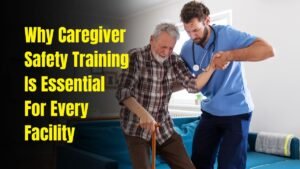In a rapidly evolving healthcare landscape, training caregivers isn’t optional — it’s essential. Facilities demand staff who are not only competent but confident, safe, and mission-driven.
In this deep dive, we’ll explore the top training programs shaping exceptional caregivers, compare their structures, detail essential competencies, and offer insights into building a sustainable caregiver development path.
Why Quality Caregiver Training Is Essential
- Patient safety and quality hinge on caregivers who understand infection control, safe transfers, communication, and documentation with precision.
- Regulatory requirements increasingly mandate minimum training hours, topic coverage, and ongoing in-service education.
- High turnover and burnout plague direct care roles; robust foundational training and continuous support help retain talent.
- Increasing patient complexity demands caregivers who can think critically, adapt, and manage care confidently.
Core Training Programs Every Facility Needs
Below are the five foundational programs (plus continuous education) that reliably produce trusted, confident caregivers:
1. Certified Nursing Assistant (CNA) Training
Overview & Structure
- Typical total training: 105 hours (30 didactic + 75 clinical)
- Classroom modules cover fundamentals; clinicals provide supervised practice
- After training, caregivers must pass a written exam and a skills demonstration
- No prerequisite education typically required
Key Competencies Covered
- Activities of Daily Living (ADLs) such as bathing, dressing, grooming
- Safe mobility, transfers, and fall prevention
- Infection control, basic vital signs, nutrition, hygiene
- Communication, residents’ rights, documentation
Impact
A well-structured CNA program sets the baseline for safe bedside care. The emphasis on hands-on experience before independent assignments fosters both confidence and competence.
2. Home Health Aide (HHA) Training
Overview & Structure
- Minimum required hours: 75 hours total
- Includes a sequence: e.g. at least 16 hours classroom before 16 hours supervised practical
- Topics include communication, safety, personal care, nutrition, vital signs, emergencies
Key Competencies Covered
- Delivering in-home personal care (bathing, dressing, toileting)
- Monitoring basic clinical signs
- Infection prevention, emergency readiness
- Client communication, boundaries, documentation
Impact
Because HHAs often work alone in patients’ homes, their training must prepare them for autonomy, decision-making, and situational awareness. The sequencing ensures safety readiness before field deployment.
3. Hospice / Palliative Care Aide Training
Overview & Structure
- Usually similar in hours to HHA: about 75 hours, with required classroom/practical sequencing
- Emphasis on end-of-life caregiving, comfort measures, psychosocial communication
- Supervised practical sessions must be conducted under experienced RN oversight
Key Competencies Covered
- Comfort care (pain, symptom support)
- Emotional support for patients and families
- Cultural sensitivity, dignity, and grief awareness
- Basic personal care, hygiene, mobility, safety
Impact
Hospice aide training bridges the gap between technical skill and emotional intelligence. Caregivers emerge with readiness to support patients in sensitive, high-empathy settings.
4. Basic Life Support (BLS) for Healthcare Providers
Overview & Structure
- Short-duration course (often 3–4 hours) with skills check
- Covers adult, child, infant CPR, use of AED, team-based response
Key Competencies Covered
- High-quality chest compressions
- Use of Automated External Defibrillators (AEDs)
- Rescue breaths, ventilations, and barrier devices
- Team roles in multi-rescuer scenarios
Impact
BLS is often a requirement for many healthcare roles. It instills a baseline confidence in handling medical emergencies and supports safer response across care units.
5. Dementia & Alzheimer’s Care Training (Annual / Specialized)
Overview & Structure
- Many facilities require 12 hours of in-service training annually, with dementia and abuse prevention included
- Some states impose additional dementia-specific training hours for care staff
Key Competencies Covered
- Person-centered communication and validation
- Behavior de-escalation and redirection techniques
- Safety for cognitively impaired patients
- Ethical, respectful care and family engagement
Impact
With rising incidence of dementia, training in cognitive care is no longer niche. It’s essential for caregiving staff to deliver safe, dignified care to patients with memory impairment.
Program Comparison
| Program | Typical Hours / Structure | Core Skills Covered | Credential / Outcome | Best Use Environments |
|---|---|---|---|---|
| CNA | 105 hours: 30 didactic + 75 clinical | ADLs, transfers, infection control, vital signs, communication | State registry listing after exam | Long-term care, skilled nursing, rehab |
| HHA | ~75 hours total, including classroom + supervised practice | Personal care, safety, nutrition, basic health monitoring | Meets minimal regulatory standard | Home care agencies, community health |
| Hospice Aide | ~75 hours with sequencing | Comfort care, family communication, end-of-life support | Complies with hospice aide conditions | Hospice organizations, palliative care |
| BLS (Healthcare) | 3–4 hour course + skills check | CPR, AED use, ventilations, team response | Certification card valid 2 years | All care settings, emergency roles |
| Dementia Care / In-service | ~12 hours annually (minimum) | Validation therapy, de-escalation, safety, person-centered care | Facility compliance | Memory care units, LTC, home care |
Building a High-Impact Caregiver Development Pathway
A truly effective caregiver ladder goes beyond simply completing required programs. Here’s a model approach:
- Pre-employment baseline:
- Ensure BLS certification
- Baseline orientation in infection control, PPE, hand hygiene
- Initial core training:
- Enroll caregivers in CNA or HHA/hospice aide training
- Front-load safety and infection modules on day one
- Hands-on supervised experience:
- Guarantee exposure across ADLs, transfers, vital signs
- Assign mentors or preceptors for the first 30 or more shifts
- Competency validation:
- Formal exams for CNA; return-demonstrations on unit-specific tasks
- Coaching feedback cycles to shore up gaps
- Continuing education loop:
- Annual in-service hours, including dementia / abuse prevention
- BLS renewals
- Topic refreshers on falls prevention, pressure injury, infection trends
- Advance and expand:
- Integrate career pathways (e.g. to LPN, medication aide, specialty modules)
- Tuition assistance, “earn-while-you-learn” programs
Program Design Best Practices
- Blend simulation and live practice. Use high-fidelity manikins and scenario-based mock codes to reinforce theory before applying in clinical settings.
- Teach safety early, repeat often. Modules on hand hygiene, PPE, and fall risk should start Day 1 and be reinforced frequently.
- Embed communication training. Use structured frameworks (such as SBAR) and teach-back methods to improve handoffs.
- Track learner confidence as well as competence. Brief surveys post-modules help identify learners needing more hands-on coaching.
- Provide protected mentorship time. Preceptors should have reduced patient loads while mentoring new caregivers.
- Monitor outcome metrics. Link training outcomes to metrics like falls, pressure injuries, UTIs, readmissions to validate ROI.
Challenges & Solutions in Caregiver Training
| Challenge | Recommended Solution |
|---|---|
| Staffing constraints limit time for training | Deploy microlearning modules, staggered shifts, or weekend intensives |
| Learners with varied backgrounds | Offer bridging modules or remediation before core training |
| Skills decay over time | Use refresher labs, just-in-time drills, and periodic competency checks |
| Resistance to change or new protocols | Use peer champions, pilot teams, and continuous feedback |
| Budget constraints | Partner with local community colleges, grant funding, or tuition-reimbursement models |
Training programs are the backbone of caregiver quality. The most effective systems blend CNA or HHA/hospice aide training, BLS certification, and ongoing dementia-capable education, all tied together with mentorship, simulation, and continuous validation.
When you build structured, evidence-driven training pathways, you don’t just check regulatory boxes—you sculpt a workforce of caregivers who deliver safe, compassionate, and confident care every day.
FAQs
How long does it take to become a CNA?
Typically, state-approved CNA programs require about 105 hours of training (split between classroom and clinical) followed by a written and skills exam.
What is the minimum training requirement for a Home Health Aide?
A standard expectation is 75 hours, including both classroom and supervised practical experience—often structured so that at least 16 hours of classroom precede supervised practice.
Do caregivers need annual dementia training?
Yes. Many facilities require a minimum of 12 in-service hours annually, with dementia and abuse prevention topics included. Some states also impose additional dementia training mandates for staff working with cognitively impaired patients




